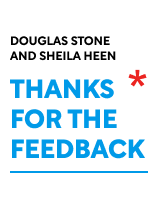

This article is an excerpt from the Shortform book guide to "Thanks for the Feedback" by Douglas Stone and Sheila Heen. Shortform has the world's best summaries and analyses of books you should be reading.
Like this article? Sign up for a free trial here .
Are you looking for Thanks for the Feedback quotes? What are some of the most noteworthy passages worth revisiting?
In their book Thanks for the Feedback, Douglas Stone and Sheila Heen walk you through how to become a better receiver of feedback so that you can more effectively incorporate it into your life and in doing so, improve your job performance and strengthen your personal relationships.
The following Thanks for the Feedback quotes highlight some of the key lessons.
Quotes by Douglas Stone & Sheila Heen
In Thanks for the Feedback, Douglas Stone and Sheila Heen, two of the co-authors of the bestseller Difficult Conversations, walk us through how to be a better receiver of feedback, examining what feedback is and how it works, how we typically react (and why), and specific techniques to successfully discuss feedback and then incorporate it into our lives.
Below is a selection of Thanks for the Feedback quotes that discuss some of the key concepts and ideas.
“Appreciation — motivates and encourages. Coaching — helps increase knowledge, skill, capability, growth, or raises feelings in the relationship. Evaluation — tells you where you stand, aligns expectations, and informs decision making.”
According to Douglas Stone and Sheila Heen, there are 3 types of feedback, each serving a different purpose:
- Evaluation
Evaluation is assessment. It accomplishes a number of things:
- It tells you where you stand, how you rank, or how you are doing in relation to expectations and to other people. Report cards, performance reviews, medals, and even nicknames are all evaluations.
- It aligns expectations between two people. Your performance review lets you know what your manager wants from you.
- It clarifies consequences. Your rating determines your bonus.
- It guides decision making. We decide whether or not to apply for the new position based on our understanding of how much our managers currently value us.
2. Coaching
Coaching is advice. It is aimed at helping you improve, learn, grow, or change, either to meet new challenges or to correct an existing problem. It helps you focus your time and energy where it matters, maintain strong relationships, and keep your efforts productive.
3. Appreciation
Appreciation is recognition and thanks. It lets you know that your efforts are noticed, making you feel worthwhile. It taps into our primitive need for acceptance. It can be motivating; the anticipation of being appreciated can encourage a person to put in the extra effort. It can also be very personal; some people will look for appreciation from a formal recognition program while others will feel more valued after a good word from a mentor.
“It doesn’t matter how much authority or power a feedback giver has; the receivers are in control of what they do and don’t let in, how they make sense of what they’re hearing, and whether they choose to change. Pushing harder rarely opens the door to genuine learning. The focus should not be on teaching feedback givers to give. The focus—at work and at home—should be on feedback receivers, helping us all to become more skillful learners.
Most try to improve their feedback systems by investing in feedback training that focuses on how to give feedback more effectively: the push. But according to the authors, a better approach is to focus on how to receive it better: the pull. In any feedback transaction, it is the receiver who controls whether or not any given piece of feedback is understood, accepted, and adopted. Therefore, focusing on the giver doesn’t get at the root of the problem. When we properly master pull, we can manage our resistance to feedback and find insight even in feedback that feels wrong, enhancing our ability to learn and improve ourselves.
“Those who handle feedback more fruitfully have an identity story with a different assumption at its core. These folks see themselves as ever evolving, ever growing. They have what is called a “growth” identity. How they are now is simply how they are now. It’s a pencil sketch of a moment in time, not a portrait in oil and gilded frame. Hard work matters; challenge and even failure are the best ways to learn and improve. Inside a growth identity, feedback is valuable information about where one stands now and what to work on next. It is welcome input rather than upsetting verdict.”
According to the authors, people who are comfortable receiving feedback (especially, negative feedback) view themselves differently. They perceive feedback as an opportunity to grow, not as an assault at who they are at their core—their identity. To create this kind of identity story—that is robust and resilient rather than brittle—you must:
- Abandon simple identity labels.
- Accept your own complexities.
- Adopt a growth mindset.
- Approach emotional reactions mindfully.
“Creating pull is about mastering the skills required to drive our own learning; it’s about how to recognize and manage our resistance, how to engage in feedback conversations with confidence and curiosity, and even when the feedback seems wrong, how to find insight that might help us grow. It’s also about how to stand up for who we are and how we see the world, and ask for what we need. It’s about how to learn from feedback—yes, even when it is off base, unfair, poorly delivered, and frankly, you’re not in the mood.”
“Pull” is the process of receiving feedback. In any feedback transaction, it is the receiver who controls whether or not any given piece of feedback is understood, accepted, and adopted. When we properly master pull, we can manage our resistance to feedback and find insight even in feedback that feels wrong, enhancing our ability to learn and improve ourselves.

———End of Preview———
Like what you just read? Read the rest of the world's best book summary and analysis of Douglas Stone and Sheila Heen's "Thanks for the Feedback" at Shortform .
Here's what you'll find in our full Thanks for the Feedback summary :
- How to better receive feedback, rather than just giving it
- Why people tend to respond negatively towards feedback
- How to successfully incorporate feedback into your life






